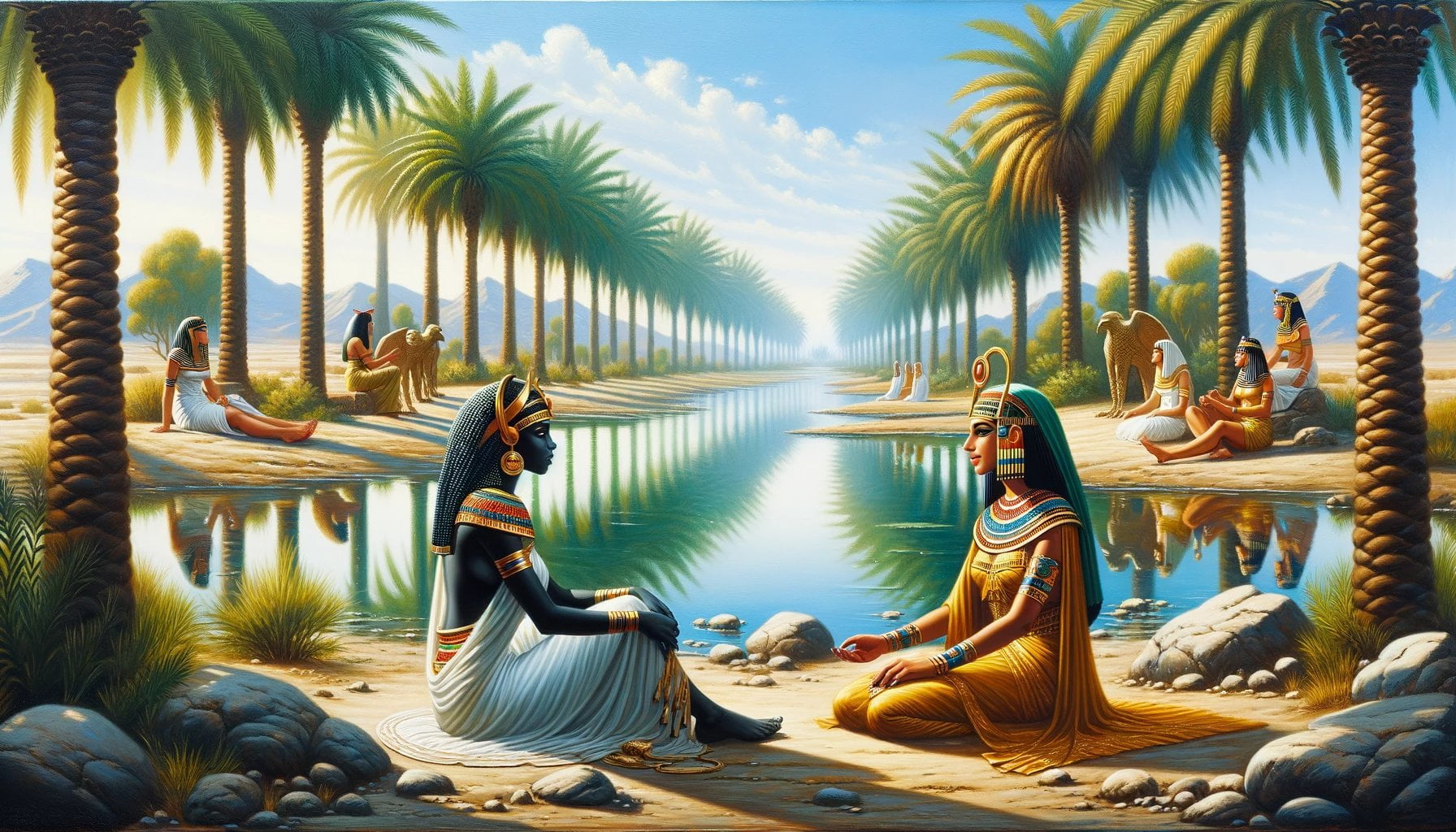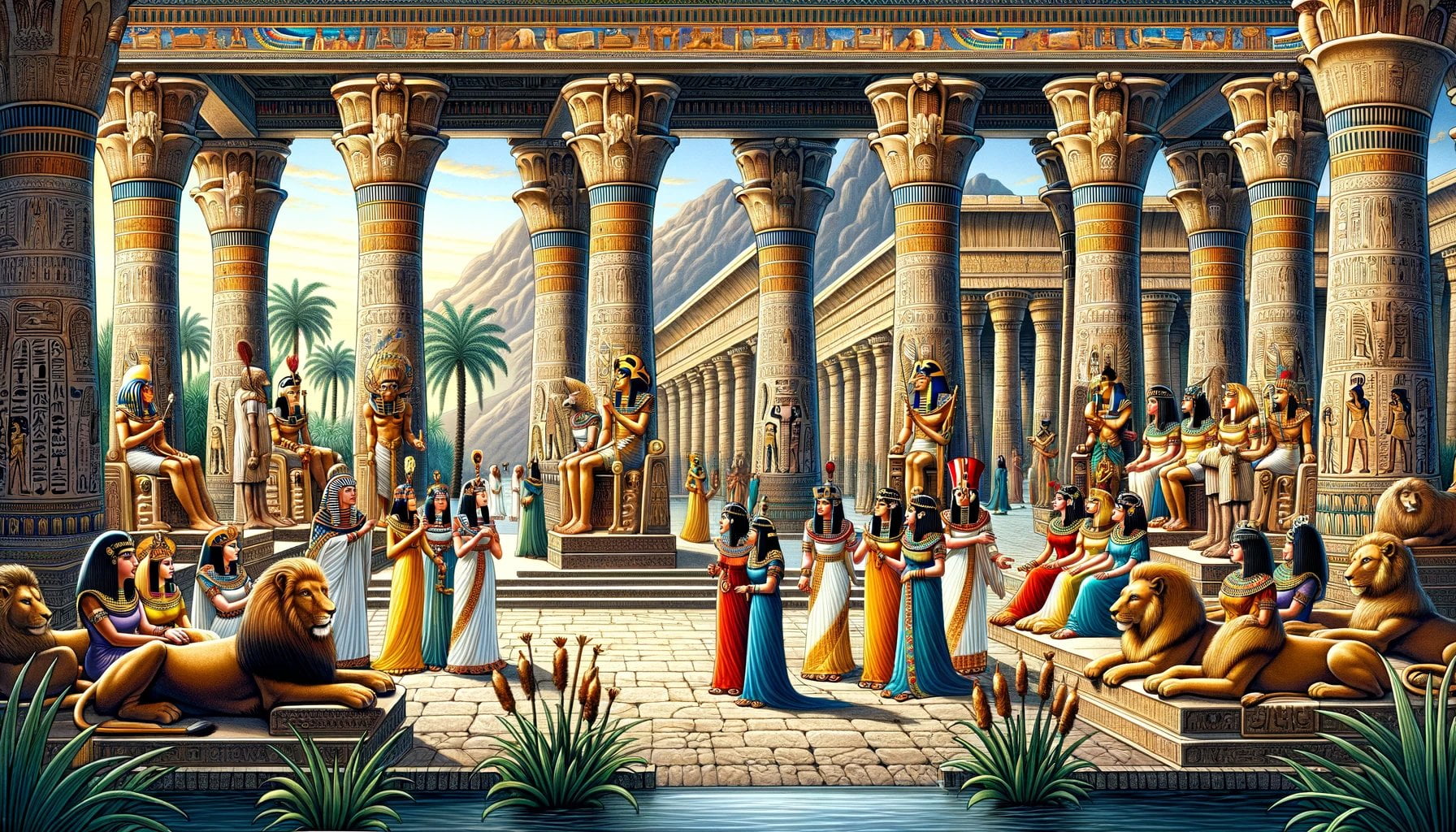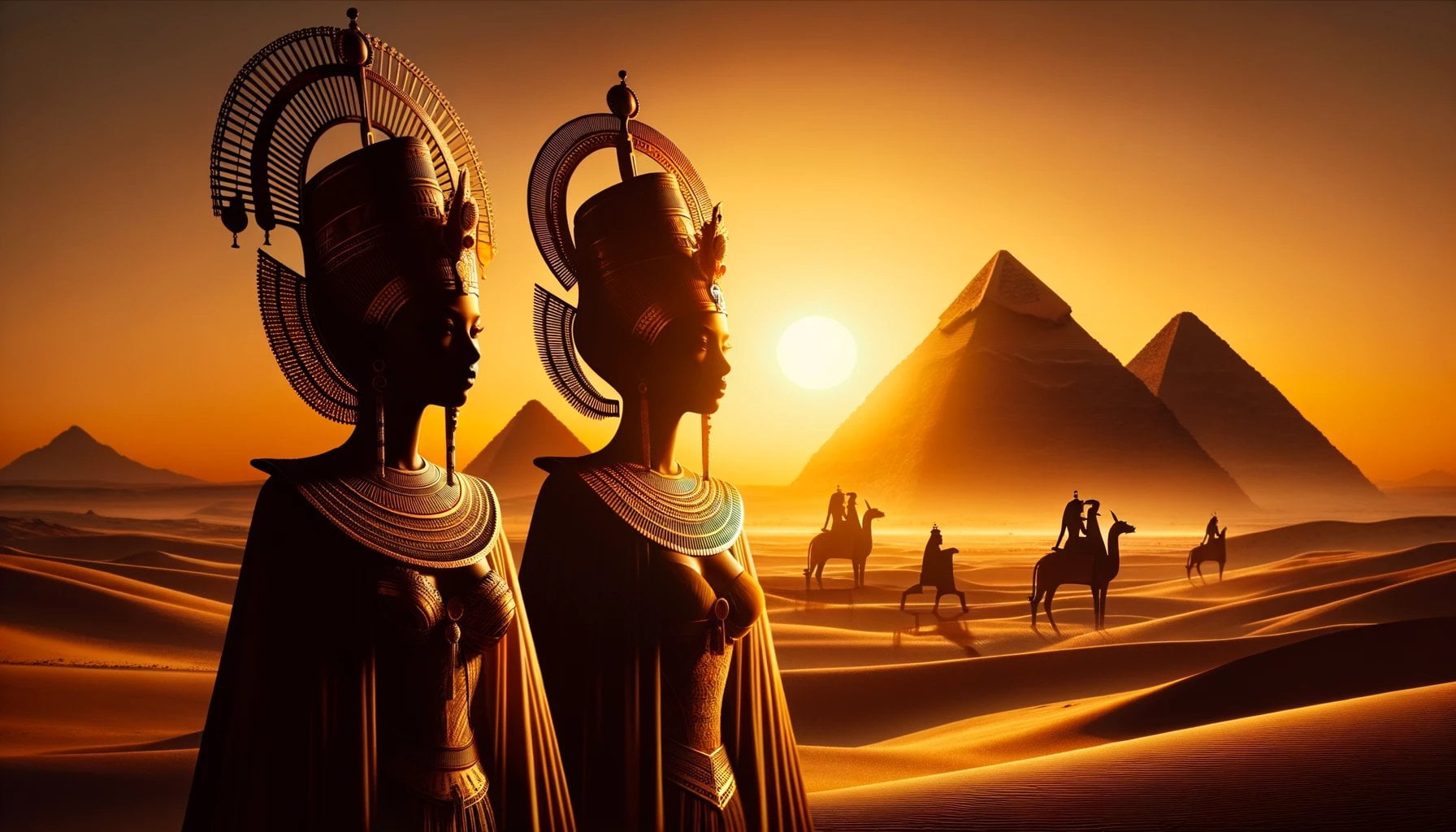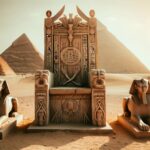Unveiling the Reign of Ancient Queens of Egypt takes readers on a fascinating journey through the captivating stories of powerful women who once ruled over the ancient land. Delving into the depths of Egyptian history, this article unravels the intricate lives and reigns of these enigmatic queens, showcasing their significant contributions and enduring legacies. With a wealth of knowledge and meticulous research, our exploration of these remarkable women provides a comprehensive and compelling narrative that transports readers back in time, shedding light on the hidden stories of Egypt’s female rulers.

Key Takeaways:
- Egyptian queens played crucial roles in the king’s right to rule and were actively involved in family, official, and religious life.
- Cleopatra, the most famous Egyptian queen, had relationships with Julius Caesar and Mark Antony, and she was the last ruler of the Macedonian dynasty in Egypt. Contrary to popular belief, Cleopatra was not of Egyptian descent, but of Greek origin.
- Hatshepsut, another notable Egyptian queen, had a reign that lasted 21 years and brought peace and prosperity to Egypt. Her mortuary complex at Deir el-Bahri had a significant impact on future pharaohs.
Unveiling the Reign of Ancient Queens of Egypt
Cleopatra: A Greek Queen in an Egyptian Kingdom
Cleopatra, one of the most renowned and enigmatic ancient queens of Egypt, captivated the world with her intelligence, beauty, and influential alliances. Despite being of Greek ethnicity, she ruled over Egypt as the last representative of the Macedonian dynasty. It is fascinating to explore how a Greek queen came to occupy such a prominent role in the Egyptian kingdom.
The Intriguing Power of Egyptian Queens
Ancient Egyptian queens held significant positions in the ruling hierarchy, playing vital roles in the king’s right to rule. As esteemed members of the royal family, they contributed to religious ceremonies, managed official duties, and even supported military campaigns. These powerful women were not just consorts; they were respected advisors and vital pillars of the kingdom.
The Legacy of Hatshepsut: A Reign of Prosperity
Hatshepsut, another remarkable ancient queen, assumed the throne of Egypt and governed for an impressive 21 years. During her reign, she brought stability, peace, and prosperity to the kingdom. Her influence extended beyond her time, as evidenced by her imposing mortuary complex at Deir el-Bahri, which would later serve as inspiration for future pharaohs.
The Enduring Impact of Ancient Queens
While Cleopatra and Hatshepsut are undoubtedly two of the most prominent ancient queens of Egypt, there were many others who left their mark on the kingdom’s history. Exploring the lives and reigns of these powerful women unveils a richer understanding of ancient Egypt’s culture, politics, and societal dynamics. From their diplomatic relationships to their administrative abilities, each queen contributed in her own unique way.
Shedding Light on Ancient Egypt’s Enigmatic Queens
Delving into the captivating stories of ancient queens of Egypt allows us to peel back the layers of time and witness the extraordinary accomplishments of these female rulers. As we scrutinize their lives, we uncover the complexities of their reigns, their contributions to society, and the intriguing connections they forged with powerful figures from the ancient world.
A Journey through Egypt’s Past: Exploring Ancient Queens
Embark on an exciting journey through the annals of history to uncover the hidden narratives of ancient Egypt’s queens. Propel yourself back in time, immersing yourself in the enigmatic world of Cleopatra and Hatshepsut, as well as the many other influential women who played pivotal roles in shaping the destiny of Egypt. Let us explore their reigns, their triumphs, and the extraordinary legacies they left behind.
Conclusion
Unveiling the lives of ancient queens of Egypt provides a captivating glimpse into an era of powerful women who defied societal norms and left an indelible mark on history. Through their remarkable achievements and enduring legacies, these queens continue to inspire and fascinate us, urging us to reflect on the untold stories that lie beneath the surface of ancient civilizations. Join us on this exploration of Egypt’s ancient queens and witness the extraordinary power they held in the land of the Pharaohs.
The Supreme God of Ancient Egypt was the most revered deity in their pantheon. Discover more about the ancient Egyptians’ beliefs and rituals surrounding their divine ruler by clicking here.
Magic played a significant role in Ancient Egypt, intriguing scholars and enthusiasts alike. Unravel the mysteries of ancient Egyptian magic by exploring the practices and spells used during that time period. Click here to delve into the enchanting world of ancient Egyptian sorcery.
The Ten Laws of Ancient Egypt governed the daily lives and interactions of its people. Uncover the rules that shaped their society, ranging from topics like crime and punishment to marriage and inheritance. To learn more about the intriguing legal system of Ancient Egypt, click here.
Birds held a special place in the hearts of the ancient Egyptians, with certain species even being venerated as gods. Discover the significance of these feathered creatures in ancient Egyptian culture and mythology by clicking here.
The crocodile god was an important figure in ancient Egyptian mythology, embodying both power and danger. Experience the ancient Egyptians’ reverence for Sobek, the crocodile god, by exploring his role and symbolism. Click here to dive into the captivating world of this ancient deity.
Did you know the ancient Egyptians invented their own form of toothpaste? Delve into the surprising history of ancient Egyptian dental hygiene and discover the ingredients they used by clicking here.
While ancient Egypt was a fascinating civilization, there were also aspects that were considered unfavorable. Explore some of the lesser-known negative aspects of ancient Egyptian culture and history by clicking here.
Black cats were highly regarded in ancient Egypt and associated with good luck and protection. Uncover the symbolism and beliefs surrounding black cats in ancient Egyptian society by clicking here.
Ancient Egypt is known for its many mysteries that continue to captivate our imagination. Journey into the enigmatic world of ancient Egyptian mysteries and uncover secrets that have endured the test of time. Click here to embark on a thrilling exploration.
Snakes held both fear and reverence in ancient Egyptian culture. Discover the significance of snakes in their mythology and daily life by clicking here.
Queen Nefertiti: The Iconic Beauty and Influential Queen
Nefertiti was more than just an iconic beauty; she was a powerful queen who left an indelible mark on ancient Egypt.
In the vast tapestry of ancient Egyptian history, few figures shine as brightly as Queen Nefertiti. Known for her unparalleled beauty, Nefertiti’s influence extended far beyond her captivating looks. She was a woman of power and authority, playing a significant role in the religious and political landscape of ancient Egypt.
Nefertiti’s Rise to Power
At the tender age of fifteen, Nefertiti married Amunhotep IV, who later changed his name to Akhenaton. Little did anyone know that this young queen would become one of the most influential figures in Egyptian history. Nefertiti’s painted sandstone bust, discovered in 1913, has become a global symbol of feminine beauty and power, immortalizing her image for generations to come.
The Reign of Nefertiti and Akhenaton
Nefertiti and Akhenaton embarked on a religious revolution in ancient Egypt, placing the sun god Aten at the center of worship. This radical departure from traditional polytheism emphasized the power of the royal family and their connection to divinity. Nefertiti’s influence in cementing these changes was remarkable, showcasing her unusual level of autonomy, as she was often depicted making offerings to the Aten even without her husband.
A Powerful Queen
Beyond her role in religious reform, Nefertiti held other significant titles and ruled over one of the wealthiest periods in ancient Egyptian history. She was not only a queen but also a consort and a great royal wife. Her authority was evident in the wall paintings found in tombs and temples, where she stood as an equal alongside Akhenaton, often portrayed in positions of power and authority.
The Legacy of Nefertiti
Although Nefertiti’s reign as a queen was cut short, her influence endured. After Akhenaton’s death, she may have ruled as a pharaoh herself, and two of her daughters went on to become queens of Egypt. Nefertiti’s impact on Egyptian history cannot be understated. Her legacy transcends her role as a beautiful queen. Through her intelligence, power, and influence, she shaped the destiny of an empire and left an unforgettable mark on the world.
Key Takeaways:
- Queen Nefertiti was not only famous for her stunning beauty but was also a powerful and influential figure in ancient Egypt.
- She played a significant role in the religious revolution alongside her husband, Akhenaton, putting the sun god Aten at the center of worship.
- Nefertiti’s authority and autonomy were evident in her depictions as an equal alongside Akhenaton, often shown in positions of power and leadership.
- She ruled during one of the wealthiest periods in ancient Egyptian history and held titles such as queen, consort, and great royal wife.
- Nefertiti’s impact lasted beyond her own reign, as her daughters went on to become queens of Egypt, solidifying her legacy as a powerful and influential queen.
Sources:
– Encyclopedia Britannica: Nefertiti | Biography, Reign, Death, Tomb, Meaning, & Facts
– Osiris Tours: Nefertiti – Beautiful and Powerful Queen of Ancient Egypt
4. Hatshepsut: The Female Pharaoh Who Ruled with Power and Charisma
The ancient Egyptian civilization was a world that witnessed the rise of extraordinary queens, who defied societal norms and left a lasting impact on history. One such remarkable ruler was Hatshepsut, the female pharaoh who ruled with power and charisma.
Hatshepsut, the fifth pharaoh of the 18th Dynasty of Egypt, became queen when she married her half-brother, Thutmose II, at a young age[^2^][^3^]. After her husband’s death, she initially acted as a regent for her stepson, Thutmose III, but eventually took on the full powers of a pharaoh, becoming co-ruler of Egypt around 1473 B.C.[^3^].
Her reign, spanning from 1479 to 1458 BCE, was relatively peaceful and marked by impressive achievements[^4^]. She embarked on an ambitious building program, constructing the famous temple at Deir el-Bahari in Luxor, a testament to her grand vision[^4^]. Her name, which means “Foremost of Noble Women” or “She is First Among Noble Women,” reflects her significant status and accomplishments[^1^].
Hatshepsut’s reign was not without controversy and intrigue. As one of the few women to rule Egypt, she faced opposition and challenges, but she managed to maintain her authority and create a lasting legacy[^7^]. Her most notable feat was her ability to rule as a male pharaoh, adopting the full titles and regalia of a pharaoh, and attaining unprecedented power for a woman in ancient Egypt[^1^]. She also expanded Egypt’s borders and contributed to its prosperity by facilitating the influx of wealth into the kingdom[^6^].
However, after her death, Hatshepsut’s legacy was largely erased, and her stepson, Thutmose III, became the dominant ruler[^7^]. Nonetheless, her reign remains an important part of Egypt’s history, serving as a testament to the power and capabilities of women in ancient societies.
Hatshepsut’s remarkable reign as the female pharaoh who ruled with power and charisma leaves us with several key takeaways:
Key Takeaways:
- Hatshepsut was the first female ruler of ancient Egypt to reign as a male pharaoh, demonstrating her unparalleled authority and strength.
- Her reign was marked by relative peace and prosperity, allowing her to embark on an impressive building program and expand Egypt’s borders.
- Hatshepsut’s ability to maintain her authority in a male-dominated society showcases her exceptional leadership abilities.
- Her reign adds an important chapter to Egypt’s rich history and sheds light on the significant contributions of ancient Egyptian queens.
- Despite attempts to erase her memory, Hatshepsut’s legacy continues to captivate and inspire, highlighting the enduring impact of powerful ancient queens.
References:
1. World History Encyclopedia. Hatshepsut. [^1^]
2. History Skills. Hatshepsut: The Woman Who Dared to Be Pharaoh. [^2^]
3. History.com. Hatshepsut: Powerful Female Pharaoh. [^3^]
4. Live Science. Hatshepsut: Powerful Female Pharaoh. [^4^]
5. Encyclopedia Britannica. Hatshepsut. [^5^]
6. The Historyville. Hatshepsut: The Female Pharaoh Who Ruled Egypt as a Man. [^6^]
7. HISTORY. Hatshepsut – Rise, Death & Legacy. [^7^]
5. Cleopatra: The Last Queen of Egypt and Her Political Intrigues
Cleopatra, often hailed as one of the most iconic figures in ancient history, holds a prominent place in the captivating narrative of Egypt’s ancient queens. Born in 70/69 BCE, Cleopatra was the daughter of King Ptolemy XII Auletes and went on to become the ruler of Egypt after his death. As the last active ruler of ancient Egypt, Cleopatra’s reign was marked by political maneuvering and strategic alliances as she sought to maintain Egyptian independence.
One of Cleopatra’s most well-known alliances was with Julius Caesar, the famed Roman general and statesman. Recognizing the importance of forging strong alliances with powerful figures, Cleopatra aligned herself with Caesar, who provided military support and political influence. Their relationship went beyond mere political strategy and resulted in a passionate romance that captured the imagination of many.
After Caesar’s assassination in 44 BCE, Cleopatra turned her attention to Mark Antony, another influential Roman figure. By forming a relationship with him, Cleopatra aimed to solidify her power and secure alliances in the Roman political landscape. Together, Cleopatra and Mark Antony formed a formidable partnership that challenged Octavian, Caesar’s adopted heir, for control of the Roman Empire.
However, their ambitions were met with defeat in 31 BCE when Octavian’s forces emerged victorious in the Battle of Actium. Cleopatra, realizing the impending conquest, tragically took her own life, marking the end of her reign and the Ptolemaic dynasty that had ruled Egypt for centuries.
Cleopatra’s legacy goes beyond her political alliances and tragic demise. Her intelligence, beauty, and political savvy have been the subject of fascination and speculation throughout history. Her reign as the last pharaoh of Egypt brought an end to the ancient civilization’s rich and complex history.
Key Takeaways:
- Cleopatra was the last queen of the Macedonian dynasty that ruled Egypt.
- She ruled as the last active ruler of ancient Egypt and sought to maintain Egyptian independence.
- Cleopatra’s political intrigue included alliances with Julius Caesar and Mark Antony.
- Her reign ended when Octavian’s forces defeated her and Mark Antony in 31 BCE.
- Cleopatra is known for her beauty, intelligence, and political acumen, leaving a lasting legacy as the last pharaoh of Egypt.
Sources:
1. Britannica – Cleopatra Biography
2. History.com – Cleopatra

FAQ
Q1: Who was Queen Nefertiti?
A1: Queen Nefertiti was a queen of Egypt and the wife of King Akhenaton. She played a prominent role in the cult of the sun god known as the Aton. Nefertiti became one of the most recognizable female figures from the ancient world after a portrait bust of her was found. She was known for her beauty and power, and her influence in the Egyptian court was significant. [^1^]
Q2: What was Queen Nefertiti’s role in ancient Egypt?
A2: Nefertiti was the Great Royal Wife of the Pharaoh Akhenaton. In wall paintings within tombs and temples, she is depicted as an equal alongside her husband, often seen in positions of authority and power. She was often shown smiting her enemies or driving a chariot, indicating her position of authority. Nefertiti and Akhenaton led a religious revolution in ancient Egypt, putting the sun god Aten at the center of religious worship. [^1^]
Q3: Did Nefertiti rule as a pharaoh?
A3: While there is speculation that Nefertiti may have ruled as pharaoh after her husband’s death, there is no conclusive evidence to support this claim. However, two of her daughters became Egyptian queens themselves, suggesting the significant influence and power she held during her time. [^1^]
Q4: Who was Queen Hatshepsut?
A4: Queen Hatshepsut was the first female ruler of ancient Egypt to reign as a male with the full authority of pharaoh. She was the fifth pharaoh of the 18th Dynasty of Egypt and became queen of Egypt when she married her half-brother, Thutmose II. After Thutmose II’s death, Hatshepsut initially acted as a regent for her stepson, Thutmose III, but eventually took on the full powers of a pharaoh, becoming co-ruler of Egypt. [^2^]
Q5: What were Hatshepsut’s notable accomplishments?
A5: Hatshepsut’s reign was relatively peaceful, and she was known for her impressive building program, including the construction of a great temple at Deir el-Bahari in Luxor. She also expanded Egypt’s borders and facilitated the influx of wealth into the kingdom, contributing to its prosperity. Her ability to rule as a male pharaoh and her lasting impact on Egypt’s history make her reign significant. [^4^]
- Sept 31 Myth: Unveiling Calendar Secrets - March 18, 2025
- How Long & Till December 18, 2025: Accurate Countdown Guide - March 18, 2025
- Discover Japanese Artists: A Complete History - March 18, 2025
















